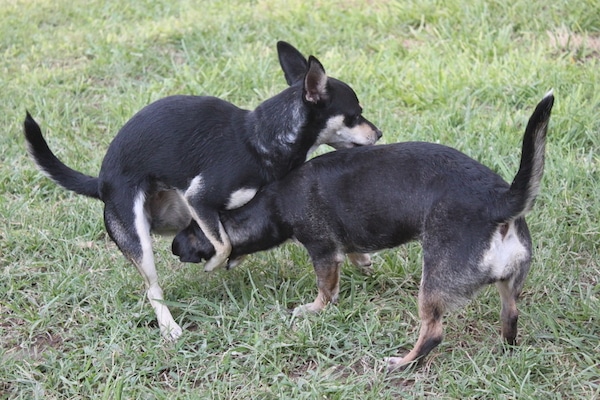Mounting (or “humping”) in dogs is frequently described as a “dominant” behavior. Like most behaviors which are commonly ascribed to dominance, such a label grossly oversimplifies the behavior. What about dogs who “air hump?” Are they trying to dominate the air? Does that even make sense?
While it is true that mounting in dogs can be a status-seeking behavior, this is only one possible reason a dog may exhibit mounting behavior.
The 7 Reasons for Dog Humping
These reasons include, but are not limited to:
1. Stress or insecurity
you see this often in undersocialized dogs or dogs who are unsure of their environment. I had a client with such a dog. He tried to punish his dog for mounting another male dog because he “didn’t want his dog to be gay.” (Yes, seriously.) This despite the fact that his dog also mounted female dogs and female humans and showed myriad other signs of stress! The problem with punishing this dog is that doing so exacerbated the dog’s stress and therefore increased the mounting behavior.
2. It feels good
I’m just going out on a limb here, but I’m guessing that some dogs simply do this because they like the way that it feels.
3. For attention
some dogs likely hump other dogs, people, or household items because it gets them attention from their owner, even if that attention is in negative form like scolding or other reprimands.
4. Reproductive rehearsal
play is often a way for animals to rehearse behaviors and skills which are important to the survival of both the individual and the species. Chasing and biting in play are ways that dogs rehearse hunting behaviors. Biting in play helps dogs learn to control the strength with which they use their teeth when interacting socially with non-prey animals. Mounting in play helps dogs rehearse, well, procreation. NOTE: when a female dog is in heat and is mounted by a male dog, it’s likely not play, but breeding.
5. Hormones
this behavior often appears initially during adolescence. It can be seen in both male and female dogs. Sometimes neutering or spaying can decrease the frequency with which this behavior is displayed, but not always. If the dog has established a history of engaging in this behavior, neutering or spaying will not solve the problem as it has since become a learned behavior.
6. Medical problem
check with your veterinarian to make sure there is no irritation, infection or inflammation in the genital area. This may be indicated especially for dogs who chew or lick at these areas excessively or compulsively.
7. Overarousal
I don’t mean sexual arousal, I mean overstimulation. The dog is beyond the threshold at which he can make appropriate social decisions and is experiencing heightened excitement levels.
Determining why your dog is mounting is the first step in developing an effective treatment plan. You will likely need the support of both a veterinarian (to rule out and address any potential medical contributing factors) and a behavior professional to learn to deal effectively with your dog’s mounting behavior.
Featured Image Credit: Jenn_C / Shutterstock








